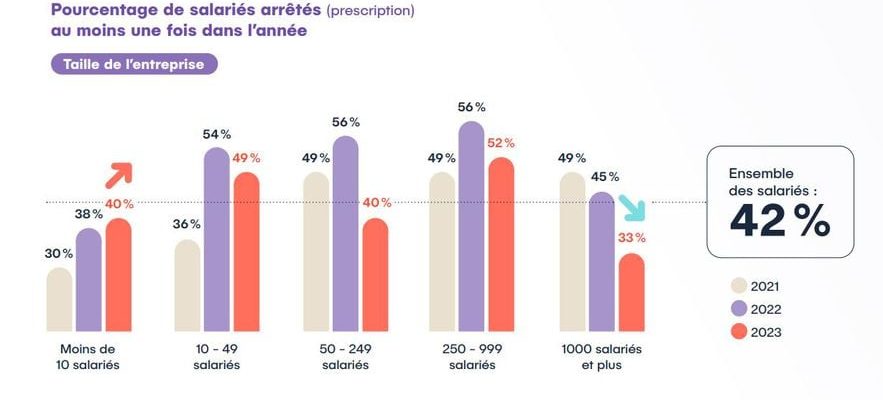Small and large businesses are not on equal footing. In terms of staff, resources… and absenteeism. According to the Malakoff humanis barometer published this Wednesday, April 17, the data intersects. While companies with more than 1,000 employees show the largest drop in sick leave – less 16 points between 2021 and 2023 – companies with fewer than 10 employees conversely record the strongest increase: more than 10 points in only three years. In companies with 10 to 49 employees, the absenteeism rate is around 50%.
Work stoppages in 2023: continued growth in small businesses.
© / Malakoff Humanis
A phenomenon which draws its source from several explanations. First, the lesser use of teleworking in small structures. Only 10% of them practice it compared to 24% of large companies. This is for a simple reason: small businesses are less present in sectors where teleworking is possible. Second, the erosion of engagement. While 55% declared themselves “engaged” in their company in 2020, only 48% of employees of small businesses are so in 2023, notes the study. And to underline: “37% of managers believe that absenteeism will increase” due, among other things, to the reduction in commitment.
Sick leave more respected
Another avenue: salary insecurity seems more significant within structures with a smaller payroll. “Financial difficulties, chronic illness, carer situation, complicated family situation” which concern a quarter of the workforce in companies with 10 to 49 employees, compared to 17% in entities with more than 1,000 employees, details the mutual.
Finally, compliance with sick leave seems to be clearly increasing in small structures. Three quarters of sick leave were taken in 2023 compared to 64% in 2022 and 58% in 2020. “A trend that can be explained by the over-representation of young people in small businesses; the latter being more inclined today to respect sick leave”, analyzes Malakoff Humanis in its report.
Health and industry, the most affected sectors
If an increase in sick leave is observed in small structures, certain age groups are more prone to absenteeism. For example, 46% of 18-34 year olds have been ordered to take sick leave compared to 37% of those over 50 in 2023. This is also the case for women. Nearly one in two women were absent at least once last year compared to only 37% of men. Perhaps more surprisingly, managers are more absent. 45% were in 2023 compared to 42% of all employees.
Furthermore, two sectors were particularly exposed to this increase in sick leave in 2023: health (52%) and industry (45%), followed closely by the construction sector (40%), commerce ( 39%) and transport (38%).
However, the Malakoff Humanis mutual insurance company has noted a return to normal in the level of absenteeism in all French companies. After a fall in 2019 and 2020, due to confinement, work stoppages experienced an unprecedented increase. In 2022, one in two employees will be required to take sick leave. A resurgence attributed to “the return to work, the relaxation of barrier gestures, and the Omicron wave”, deciphers the report. Stoppages linked to Covid-19 notably fell by 10 points between 2022 and 2023.
